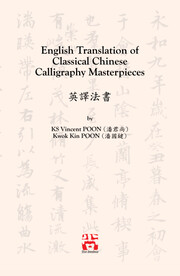Galleries and Translations > Models of Masterpieces >A model of Yan Zhenqing's "A Poem OnGeneral Pei " 臨 顏真卿書 裴將軍詩
A model of Yan Zhenqing's "A Poem On General Pei "
(臨 顏真卿書 裴將軍詩)
35 X 137cm (3) in Standard Script (楷書), Semi-cursive Script (行書), and Cursive Script (草書)
History - by KS Vincent Poon
(I)
A Poem on General Pei (裴將軍帖) is one of the many outstanding works written by the renowned Tang Dynasty minister and calligrapher Yan Zhenqing (顏真卿, AD 709-785)(1). The highlight of this masterpiece is the different script styles written within one single calligraphic work, a practice that is rarely employed in traditional Chinese calligraphy where a work is usually written in one particular script style. Standard script, semi-cursive script, along with cursive script are all compellingly, coherently, and harmoniously displayed at the same time with a touch of clerical script flavor seen in some of the brushstrokes. Indeed, this extraordinary work is regarded as “odd, strange and unprecedented (怪怪奇奇, 前無古人)”(2), “bold and open, singularly pioneering a completely new horizon (縱橫豪宕,獨闢異境)”(3), and can “startle one’s mind and shake one’s spirit (驚心動魄)”(4). Unsurprisingly, it is considered by some as the best calligraphic wonder crafted by Yan Zhenqing (魯公第一奇跡).(5) The original work can no longer be found; the best representation of the work is an ink-rubbed copy from a stone inscription of the original.
(II)
The work’s vigor, liveliness, as well as its magnificent powerful brushstrokes (筆力雄偉)(6) are consistent with Yan Zhenqing’s honest, principled, unyielding, and strong-willed personality. According to Old Book of Tang (《舊唐書》), Yan led the army against the rebellious An Lushan (安祿山, 703-757AD), frequently gave candid and forthright admonitions to the Emperor despite offending many high officials, and never betrayed Tang even being threatened and eventually executed by Li Xilie (李希烈, ?-786AD).(7) Thus, he was regarded by Tang Emperor Dezong (唐德宗) as talented, outstanding, faithful and having an unbending will (“器質天資,公忠傑出”, “堅貞一志”).(8)
(III)
Yan Zhenqing’s calligraphy is often modelled and studied by many today. While it is certainly important to mimic and learn the exterior physical forms of Yan’s script, most have forgotten to emulate Yan’s noble temperament in achieving a higher level in the art of calligraphy; indeed, “to not pursue learning the fundamental qualities but only to model the exterior superficial qualities cannot be regarded as a good learner (不求其本, 而但倣其面目,亦未為善學者也)”(9). Truly, the art of Chinese calligraphy is fundamentally “a testament to one’s moral character (驗燥濕之殊節)”(10), and so “the essence and ingenuity of shudao/shodo (書道) is temperament, while being capable to scribe well the exterior physical forms comes second (書道妙在性情,能在形質)”(11). Hence, learning calligraphy without cultivating one’s temperament shall certainly limit one’s calligraphic achievement.
(IV)
Yan’s A Poem on General Pei was written in dedication to Tang Dynasty’s famed general Pei Min (裴旻, ?-?AD), who was renowned for his swordsmanship, might, audacity, and valor in defending the country against the nomadic Xi (奚).(12) Pei Min’s swordplay, Li Bai’s (李白, 701-762AD) poems, and Zhang Xu’s
(張旭, 675-750AD) cursive script were decreed together by Emperor Wenzong (唐文宗, 809-840AD) as the “Three Ultimates of Tang Dynasty (唐代三絕)”.(13)
Line-by-line English translation of A Poem About General Pei
(2018 revised edition by KS Vincent Poon)
English Translation
Original Chinese
1. 裴將軍!
2. 大君制六合,猛將清九垓。
3. 戰馬若龍虎,騰陵 何壯哉!
4. 將軍臨北荒,怛 赫耀英材。
5. 劔舞躍游雷,随風縈且迴。
6. 登高望天山,白雪正崔嵬 。
7. 入陣破驕虜,威聲雄震雷。
8. 一射百馬倒,再射萬夫開 。
9. 匈奴不敢敵,相呼歸去來。
10. 功成報天子,可以畫麟臺。
General Pei!
While the glorious Emperor commanded all under the Heavens (六合), your fierce troops brought peace (清) to the entire country (九垓).
FOR FURTHER TRANSLATION, FOOTNOTES, AND ELABORATIONS
PLEASE SEE :
English Translation of Classical Chinese Calligraphy Masterpieces 英譯法書
by KS Vincent POON and Kwok Kin POON (Feb. 2019)
ISBN 978-1-7753221-1-5
There are currently no satisfactory English translations of prominent classical Chinese calligraphy masterpieces (法書, exemplary works that are worth for all to study and observe) like Cao Quan Stele (曹全碑) and Lanting Xu (蘭亭帖). This is the first book that offers line-by-line English translations of the following five Chinese calligraphy masterpieces along with detailed annotations and explanations using historical reference books and texts:
- 1. Cao Quan Stele (曹全碑) by an unknown calligrapher (185AD);
- 2. Lanting Xu (蘭亭帖) by Wang Xizhi (王羲之, 303-361AD);
- 3. Elaborations on the Chronicle of Ni Kuan (兒寬贊帖) by Chu Suiliang (褚遂良, 596-658AD);
- 4. A Poem on General Pei (裴將軍帖) by Yan Zhenqing (顏真卿, 709- 785AD);
- 5. Huai Su’s Autobiography (懷素自叙帖) by Huai Su (懷素, 725-785 AD or 737-799 AD).
Previous attempts by renowned scholars such as Patricia Ebrey (in translating Cao Quan Stele) and LIN Yutang (林語堂, in translating Lanting Xu) contain significant errors and omissions and will be briefly discussed in this book. Hence, serious learners of Chinese calligraphy as well as scholars studying traditional Chinese culture will find this book particularly useful.
WORLDCAT/LIBRARY: [Worldcat] [Columbia U] [HKU] [CUHK] [Universiteit Antwerpen] [Wesleyan U] [Kyoto U] [National Taiwan U]